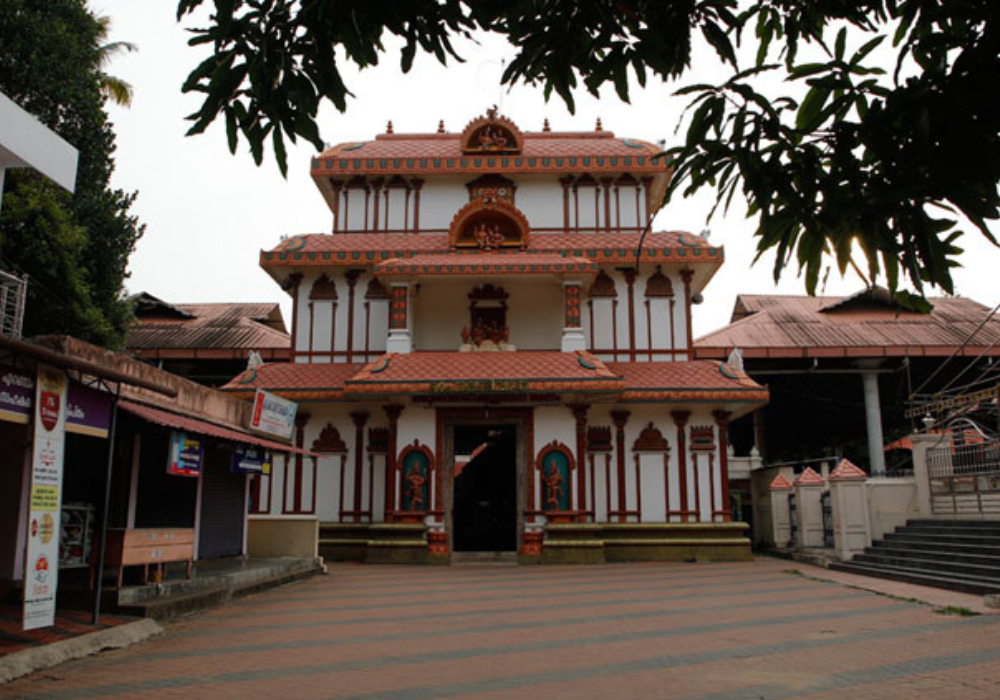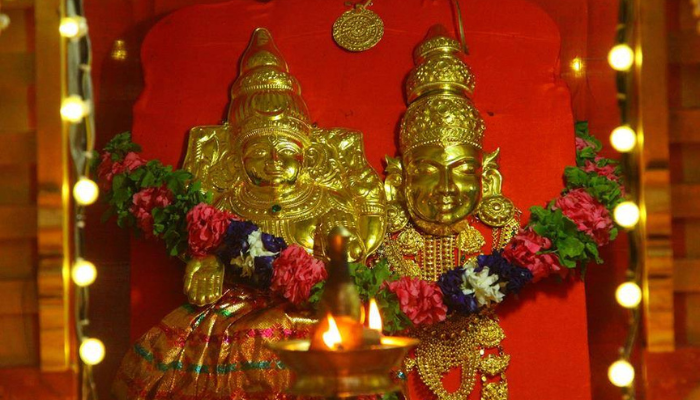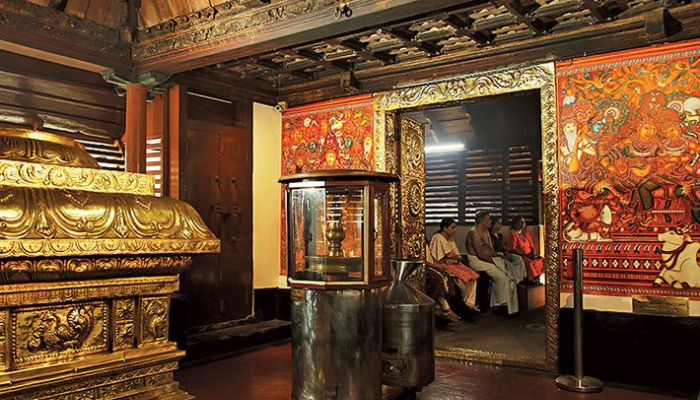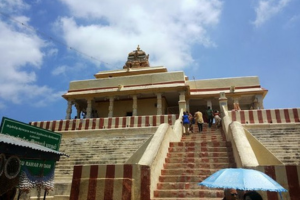
Nestled amidst Kerala‘s serene landscapes, the Thiruvairanikulam Temple symbolizes profound devotion. This ancient shrine holds immense spiritual importance. Devotees across India revere this site. Its official name is the Thiruvairanikulam Mahadeva Temple. It is renowned for a unique annual tradition. Goddess Parvati is Lord Shiva’s divine consort. Her shrine opens its doors to the public. This happens for just twelve days each year. This exclusive period draws thousands of pilgrims. They eagerly seek blessings. Exploring the rich Thiruvairanikulam Temple history reveals fascinating legends. It also shows architectural marvels. Knowing the precise Thiruvairanikulam Temple location is essential. This helps in planning a visit to this sacred destination.
The Enigmatic Annual Opening of Goddess Parvati's Shrine

The Thiruvairanikulam Mahadeva Temple has a distinctive feature. Goddess Parvati’s sanctum rarely opens. This occurs for a mere twelve days annually. Devotees know this special event as the “Nadathurappu Mahotsavam.” It begins on the Thiruvathira Nakshatra. This star falls in the Malayalam month of Dhanu. This period typically spans from mid-December to mid-January. These dates vary slightly each year. Devotees eagerly anticipate this specific time. The limited access adds to the temple’s mystique. It enhances its spiritual allure.
During these twelve auspicious days, the temple transforms. It becomes a vibrant hub of spiritual activity. Thousands of pilgrims visit the temple. Many of them are women. They seek blessings from Goddess Parvati and pray for a happy married life. They also ask for wish fulfillment. People sometimes affectionately call the temple the “Sabarimala of women.” This name highlights its significance. It is a key destination for female devotees. Daily worship and offerings continue. These occur inside the Goddess’s sanctum all year. This happens even when it remains closed to the public.
Nadathurappu Mahotsavam: A Time of Deep Devotion
The Nadathurappu Mahotsavam is more than an opening of doors. It is a grand celebration. Elaborate rituals mark this event. Fervent prayers fill the air. The festivities begin with a colorful procession. This procession carries the deities’ holy ornaments. These come from Akavoor Mana. Priests then adorn Goddess Parvati with these ornaments. The temple’s atmosphere during this festival is exceptionally spiritual. It feels very vibrant. Visitors planning to experience this unique event should note the darshan timings. During the festival, the temple remains open. It is open from 4:30 AM to 1:30 PM and reopens from 4:30 PM to 8:30 PM. It is advisable to check the exact dates each year. These dates vary based on the Malayalam calendar. This ensures a well-planned and fulfilling pilgrimage.
The Nadathurappu Mahotsavam is a spiritual magnet. It draws devotees seeking divine grace. The unique tradition emphasizes the Goddess’s sanctity. It also highlights the temple’s revered status. Pilgrims often perform special vows. They offer specific prayers during this time. The energy is palpable. Chants and devotional songs fill the air. Experiencing this festival offers deep spiritual insight. It is a profound connection to ancient traditions. Many believe that prayers offered during these twelve days hold special power. The temple committee manages the crowds efficiently. They ensure a smooth darshan for all visitors. This annual event is a testament to enduring faith. It showcases Kerala’s rich cultural heritage.
Unveiling the Ancient Thiruvairanikulam Temple History

The Thiruvairanikulam Temple history spans over a millennium. Its exact construction date remains somewhat mysterious. However, historical records suggest active worship. This started at least by the 9th century CE. Some estimates even place its origins earlier. They suggest between 1000 and 2000 years ago. This makes it one of Kerala’s most ancient Shiva-Parvati temples. The temple’s rich past is interwoven with captivating myths. It also includes historical accounts. These narratives explain its unique traditions. They define its sacred status.
Legends of Origin: The Self-Manifested Deity
Two prominent narratives trace the Thiruvairanikulam Mahadeva Temple’s origin. One legend speaks of a conflict. This occurred within the Akavoor Mana family. It led a section of the family to Vellarapilly. There, they discovered a self-manifested stone idol. This was Lord Shiva. They named it Airanikulathappan and recognized its divine nature. They then constructed a temple around it. The name eventually evolved to Thiruvairanikulam. This story highlights the deity’s spontaneous manifestation. It also underscores the temple’s deep spiritual roots.
Another captivating legend involves two Brahmin families. These were Akavoor Manakkal and Akavoor Chathan. These families found solace in worship. They revered different forms of the same deity. Manakkal worshipped Lord Shiva. Chathan revered Goddess Parvati. Eventually, both forms found their place. They came together within the Thiruvairanikulam Temple. This symbolizes unity in duality. A related tale describes an old Brahmin. He was a devotee of Lord Shiva. He grew too frail to visit the original temple. Akavoor Chathan, a boatman, made a granite boat. He used it to ferry the Brahmin. One day, the Brahmin returned. His palm leaf umbrella felt unusually heavy.
This indicated Lord Shiva had chosen to accompany him. Later, a woman sharpened her sickle. She used a granite stone. She witnessed blood flowing from it. Chathan identified this stone. It was the self-manifested Shiva idol. This led to the temple’s construction. It was built at its current Thiruvairanikulam Temple location.
The Legend of Goddess Parvati’s Shrine Closure
The unique tradition of Goddess Parvati’s shrine has a compelling legend. It opens for only twelve days. People believed that Goddess Parvati secretly prepared food. This was ‘Naivedyam’ for Lord Mahadeva. She did this in the temple kitchen. No one was permitted inside the kitchen. This was during her sacred act. However, one night, a temple priest entered. He was from the Uranmakkar group. Curiosity drove him. He saw the Goddess in her divine form. He exclaimed in awe.
Goddess Parvati felt her privacy violated. She became angry. She declared her intention to leave the temple.
The Brahmin felt remorse. He pleaded for her mercy. He performed intense austerities. Eventually, the Goddess relented. She agreed to make her presence felt. This would be in the sanctum for twelve days each year. This period begins from the Thiruvathira Nakshatra. It falls in the month of Dhanu. This day is also Lord Shiva’s birthday. This legend explains the strict adherence. It enforces the twelve-day opening. It also underscores the deep reverence. This is for both deities. It is at the Thiruvairanikulam Mahadeva Temple.
Historically, ancient Tamil works mention the temple. This indicates its prominence. It was significant during the early medieval period. People also believe the Chera dynasty patronized the temple. They ruled much of Kerala during its golden age. The temple has remarkably survived invasions. It also endured natural calamities over centuries and stands as a resilient symbol of faith and representing enduring cultural heritage, and its history is a testament. It shows the continuous spiritual traditions of Kerala. These narratives connect the present to a glorious past. They highlight the temple’s enduring spiritual power. The temple’s resilience reflects the devotion of its followers. It also shows the strength of its divine protection.
Architectural Grandeur and Spiritual Aura
The Thiruvairanikulam Mahadeva Temple showcases stunning architecture. It is a prime example of traditional Kerala temple design. This style beautifully blends Dravidian influences. It also incorporates distinctive local elements. The temple’s design creates a profound environment. It is both spiritual and aesthetically pleasing. Every detail reflects centuries of craftsmanship. This includes its layout and intricate carvings. It also shows deep devotion. Visitors often feel tranquility. They experience reverence upon entering this sacred space.
Distinctive Architectural Features
The temple structure features unique elements. It has a two-tiered circular sanctum. People call this a Sreekovil. This Sreekovil houses the main deities. Intricate wood carvings adorn the roof. They also decorate the pillars of the sanctum. These carvings depict various mythological scenes. A spacious Nalambalam surrounds the sanctum. This is an inner courtyard. It provides ample space for circumambulation. Beautiful mural paintings enhance the temple’s artistic appeal. These murals often portray celestial battles. They also show divine festivities.
A grand Dwajasthambam stands proudly. This is a flagstaff. It is at the temple’s entrance. This is common in South Indian temples. It signifies the divine presence. The Sreekovil walls feature wooden ‘vyali’ figurines. These are mythical dragon-like creatures. Carvers placed them over elephant heads. The ceiling of the Namaskara Mandapam displays exquisite carvings. This is a pavilion. These carvings illustrate episodes from Deva-Asura battles. They also show Devotsava. They include depictions of the Nava Grahas. These are the nine planets. These architectural details provide a visual narrative. It tells of Hindu cosmology and epic tales. The craftsmanship is truly remarkable. It reflects deep spiritual understanding. Artisans poured their devotion into every detail. This makes the temple a living piece of art.
The Unique Positioning of Deities
The Thiruvairanikulam Temple has a remarkable feature. It is the positioning of its main deities. Most Hindu temples have deities facing each other. However, Lord Shiva and Goddess Parvati here face opposite directions. Lord Shiva, worshipped as Mahadeva, faces east. Goddess Parvati faces west. This unique alignment is not just architectural. It symbolizes their complementary divine energies. It represents their distinct yet harmonized roles. This is in the cosmic universe. This duality in unity offers a profound spiritual lesson. It teaches devotees about balance and coexistence.
The temple’s overall spiritual aura is palpable. The serene environment combines with profound spiritual energy. This makes it a must-visit destination. It offers an enriching experience. This is true for devoted pilgrims or curious travelers. The temple promises a lasting impression. It touches the soul. The blend of ancient history creates atmosphere. It has unique traditions and stunning architecture. This fosters deep reverence and spiritual connection. Every corner of the temple exudes peace. It invites introspection. The air itself seems to carry ancient prayers. This enhances the pilgrim’s spiritual journey.
Deities and Their Significance at Thiruvairanikulam Mahadeva Temple
At the heart of the Thiruvairanikulam Mahadeva Temple reside its principal deities. These are Lord Shiva and Goddess Parvati. Devotees worship them with immense devotion. Lord Shiva is revered as Mahadeva. The main sanctum houses a powerful Shiva Lingam. This Lingam is believed to be ‘swayambhu’. This means it is self-manifested. Devotees believe this form of Shiva bestows blessings. It removes obstacles from their lives. His shrine is open throughout the year. This allows continuous worship. He receives four ‘Naivedyam’ offerings daily.
Goddess Parvati: The Divine Consort
Goddess Parvati is the divine consort of Lord Shiva. She is equally significant. Her shrine faces west. This is opposite Lord Shiva’s east-facing shrine. As previously mentioned, her sanctum opens for only twelve days. This happens each year. This unique tradition makes her darshan exceptionally auspicious. Devotees, particularly women, visit during this period. They seek blessings for marital harmony. They also pray for a happy family life and ask for the fulfillment of their desires. Her idol is carved from wood. It receives a special anointing. Turmeric paste is used instead of water. This is for the ‘Abhishekam’ ritual. This maintains a unique form of worship. It is very traditional. This special ritual highlights her unique place in the temple.
Sub-Deities and Their Roles
Beyond the main deities, the Thiruvairanikulam Temple complex houses other shrines. These are dedicated to several important deities. Each sub-deity plays a significant role. They are part of the temple’s spiritual ecosystem and attract devotees with specific prayers. They also receive specific offerings.
The presence of these multiple deities reflects the rich tapestry. It shows Hindu mythology and worship. This is within the Thiruvairanikulam Mahadeva Temple complex. It allows devotees to seek blessings. They ask for a wide array of needs and aspirations. This comprehensive spiritual environment truly makes the temple a powerful center of faith. Each deity contributes to the temple’s spiritual vibrancy. They offer unique pathways for devotees to connect with the divine. The harmonious coexistence of these deities symbolizes the unity of different spiritual paths.
Thiruvairanikulam Temple Location: Reaching the Sacred Abode
The Thiruvairanikulam Temple location is a significant factor. This applies to pilgrims and tourists planning a visit. This revered shrine is situated in Vellarappally. It is near Kalady. This is in the Ernakulam district of Kerala, India. Kalady itself holds historical importance. It is the birthplace of the great philosopher Adi Shankara. This proximity adds another layer. It provides cultural and spiritual depth to the temple’s setting. The temple is approximately 15 km south of Aluva. It lies near Sreemoolanagaram village. This is on the banks of the Periyar River.
Accessibility by Road
Reaching the Thiruvairanikulam Temple is convenient. This is due to well-connected road networks. Regular buses and taxis are available. They connect from major cities and towns in Kerala. These include Thrissur, Cochin, and Aluva. Perumbavoor, Angamaly, and Chalakudy are also connected.
Accessibility by Rail and Air
The temple is also well-connected by rail and air. This makes it accessible for devotees from further away.
The temple’s strategic Thiruvairanikulam Temple location ensures easy access. Devotees can easily plan their pilgrimage. Whether by road, rail, or air, reaching this sacred abode is a straightforward journey. The serene setting adds to the spiritual experience. It offers a peaceful retreat for reflection and worship. This accessibility makes the temple a popular pilgrimage site. It draws visitors from all corners of the globe. Planning ahead ensures a smooth and memorable visit.
Festivals and Celebrations at Thiruvairanikulam Temple
The Thiruvairanikulam Mahadeva Temple is a vibrant center. It hosts cultural and spiritual celebrations. It holds several significant festivals throughout the year. These events attract devotees from far and wide. They showcase Kerala’s rich traditions. They also display deep-rooted customs. The festive atmosphere adds allure. It enhances this sacred site. Each festival holds unique importance. It involves specific rituals.
Nadathurappu Mahotsavam: The Premier Festival
As previously highlighted, the Nadathurappu Mahotsavam is the most prominent festival. This annual event marks the opening of Goddess Parvati’s shrine. It occurs for twelve days. It starts on the Thiruvathira day. This is in the Malayalam month of Dhanu. This typically falls between mid-December and mid-January. This period is extremely auspicious. It is particularly so for women. They seek blessings for marriage. They also pray for family well-being. The festivities involve elaborate processions. Traditional music and dance performances are also part of it. The entire temple complex buzzes with divine energy. This occurs during these special days. The vibrant celebrations create an unforgettable experience. They draw thousands of eager devotees.
Other Important Festivals
Apart from the Nadathurappu Mahotsavam, the Thiruvairanikulam Temple celebrates other festivals. These are dedicated to its various deities:
These festivals not only attract devotees. They also beautifully showcase Kerala’s rich traditions. They display its religious customs. Visiting the Thiruvairanikulam Temple during any festive period offers a unique cultural experience. It is very immersive. It allows one to witness the spiritual fervor firsthand. The air during these times is charged with devotion. It creates a memorable pilgrimage. These events underscore the temple’s role. It is a vital center of community and faith.
Rituals and Offerings at Thiruvairanikulam Mahadeva Temple
The Thiruvairanikulam Mahadeva Temple adheres to traditional rituals. It follows ancient practices. Devotees participate in various offerings. They also engage in ceremonies. This is to seek divine blessings. These rituals are performed with great sanctity. They show precision and form an integral part. They enhance the spiritual experience at the temple. Understanding these practices can enrich a visitor’s pilgrimage. They reveal the depth of devotion.
Daily Rituals and Unique Practices
Lord Shiva is the presiding deity. He receives daily worship throughout the year. Four ‘Pooja’ services are offered to him. This includes ‘Naivedyam’. Goddess Parvati’s shrine opens for only twelve days. Despite this, she also receives daily worship. She gets one offering. Priests prepare this with special reverence.
The temple has several unique rituals. These set it apart:
Offerings for Specific Blessings
Many devotees visit the Thiruvairanikulam Temple. They come with specific prayers. The temple offers various ‘vazhipadu’ (offerings). These cater to their intentions. For those seeking blessings for marriage, special offerings are highly recommended. These include ‘Manjalpara’, ‘Thali’, and ‘Pattu’. These offerings are especially auspicious. They are for unmarried individuals and seek good fortune in their love lives. They also pray for marital harmony.
Other popular ‘pujas’ and offerings include ‘Ottappam’ and ‘Ganapathi Homam’. The temple provides detailed information. This is on these offerings. It often includes associated prices. Devotees can typically book these ‘vazhipads’. This is done at the temple counters. In some cases, online booking is available. The temple staff provides guidance. They assist in participating in these rituals and ensure devotees follow appropriate customs. They also enforce dress codes. Traditional Kerala attire is generally required for darshan. This means dhoti for men and sarees for women. This adherence preserves the temple’s sanctity. It respects its ancient traditions.
The strict adherence to traditional rituals makes the temple unique. The wide range of offerings further enhances this. This makes the Thiruvairanikulam Mahadeva Temple a deeply spiritual experience. It allows devotees to connect with the divine. This connection is profound and meaningful. The temple’s commitment to preserving these ancient practices enhances its sanctity. It draws countless believers. Each ritual is performed with utmost care. This ensures the spiritual integrity of the temple. The atmosphere of devotion is truly inspiring for all who visit.
Pilgrimage Experience: What to Expect at Thiruvairanikulam Temple
Visiting the Thiruvairanikulam Temple offers a truly immersive spiritual journey. It is more than just a site of worship. It is a place for profound connection. Pilgrims should prepare for a unique experience. This includes cultural immersion. The temple’s serene environment encourages reflection. The spiritual energy is palpable. It provides a peaceful retreat. Many visitors describe a sense of calm. They feel deep spiritual upliftment. This happens upon entering the sacred premises.
Planning Your Visit
Planning your trip is crucial. Especially if you aim for the Nadathurappu Mahotsavam. This twelve-day period attracts massive crowds. Book accommodations well in advance. Check the exact festival dates. These vary annually. The temple publishes these dates. They are based on the Malayalam calendar. Arrive early on festival days. This helps to secure a good darshan. Weekdays are generally less crowded. Weekends and holidays see more visitors. Dress modestly. Traditional attire is preferred. Men wear dhotis. Women wear sarees or traditional Indian wear. This shows respect for the sacred space. Photography restrictions may apply. Always check with temple authorities beforehand. This ensures a respectful visit.
Facilities and Amenities
The temple complex provides basic facilities. These cater to pilgrims’ needs. There are restrooms available. Drinking water facilities are also present. During major festivals, temporary arrangements increase. These handle the large influx of devotees. Food stalls may operate. They offer local snacks and meals. The temple administration often organizes ‘Annadanam’. This is a communal meal. It is particularly during the Lord Mahadeva’s festival. This provides food for all pilgrims. Parking facilities are available. These can become limited during peak seasons. It is advisable to use public transport. Taxis or auto-rickshaws are convenient. They can drop you closer to the entrance. This avoids parking hassles.
Cultural Etiquette and Respect
Observing local customs is important. Remove your footwear before entering the temple. Maintain silence inside the sanctum. Avoid loud conversations. Respect the sanctity of the place. Follow instructions from temple volunteers. They guide pilgrims and manage queues. They ensure smooth flow. Do not touch idols. Do not touch sacred objects. This is unless permitted by priests. Participate in rituals with an open heart. Embrace the spiritual atmosphere. This enhances your personal experience. The temple’s vibrant traditions offer a rich cultural insight. Engage with the local community. Learn about their customs. This enriches your pilgrimage further. Many local shops sell devotional items. They also offer souvenirs. This supports the local economy. It also provides mementos of your visit.
The pilgrimage to Thiruvairanikulam Temple is deeply rewarding. It offers spiritual solace. It provides a connection to ancient traditions. The unique annual opening of Goddess Parvati’s shrine is a highlight. It provides a rare spiritual opportunity. Prepare adequately for your visit. Immerse yourself in the temple’s divine aura. This ensures a memorable and blessed experience. Many devotees return year after year. They seek the Goddess’s blessings. They experience the profound spiritual energy. The temple stands as a beacon of faith. It continues to inspire generations of devotees.
FAQ: Frequently Asked Questions About Thiruvairanikulam Temple
Here are some common questions. These provide additional information. They help pilgrims plan their visit to the Thiruvairanikulam Mahadeva Temple.
1. What is the most unique feature of Thiruvairanikulam Temple?
The most unique feature is Goddess Parvati’s shrine. It opens for only twelve days each year. This period is known as the “Nadathurappu Mahotsavam.” It attracts thousands of devotees. This limited access makes her darshan exceptionally sacred. It is a very rare opportunity.
2. When does the Nadathurappu Mahotsavam usually occur?
The Nadathurappu Mahotsavam typically occurs between mid-December and mid-January. It begins on the Thiruvathira Nakshatra. This falls in the Malayalam month of Dhanu. Devotees should check the temple’s official calendar. This ensures they get the exact dates for the specific year.
3. Can men also visit Goddess Parvati’s shrine during the festival?
Yes, both men and women can visit Goddess Parvati’s shrine. This is during the Nadathurappu Mahotsavam. While many women visit for specific blessings, the temple welcomes all devotees. Everyone can seek blessings from the divine consort.
4. What are the main deities worshipped at Thiruvairanikulam Temple?
The main deities are Lord Shiva (Mahadeva) and Goddess Parvati. Lord Shiva’s shrine is open all year. Goddess Parvati’s shrine opens only for twelve days. The temple also houses shrines for sub-deities. These include Lord Ganesha, Lord Subrahmanya, and Lord Vishnu.
5. How do I reach Thiruvairanikulam Temple?
The temple is near Kalady, in Ernakulam district, Kerala. You can reach it by road, rail, or air. The nearest railway stations are Aluva and Angamaly. Cochin International Airport (CIAL) is the closest airport. Regular buses and taxis are available. These connect from major Kerala cities. The precise Thiruvairanikulam Temple location is easily accessible.
6. Are there any dress code requirements for visiting the temple?
Yes, the temple has a traditional dress code. Men should wear dhotis. They can go shirtless or wear a traditional upper cloth. Women should wear sarees or traditional Indian attire. Modest dressing is always encouraged. This shows respect for the sacred premises.
7. What are some important offerings at the temple?
Devotees make various offerings. These include ‘Manjalpara’, ‘Thali’, and ‘Pattu’ for marriage blessings. ‘Ottappam’ and ‘Ganapathi Homam’ are also popular. ‘Rudra Abhishekam’ is a powerful offering for Lord Shiva. It involves ritualistic bathing of the Shiva Lingam with sacred substances like water, milk, honey, ghee, and curd, accompanied by the chanting of Vedic mantras. It is believed to invoke Lord Shiva’s blessings, purify the mind, remove negative energies, and grant prosperity and spiritual growth.
Conclusion: A Journey into Divine Grace
The Thiruvairanikulam Mahadeva Temple stands as a timeless beacon of faith and devotion in Kerala. Its rich history, captivating legends, and unique traditions make it a truly exceptional spiritual destination. The annual opening of Goddess Parvati’s shrine for just twelve days underscores its profound sanctity and draws countless devotees seeking divine blessings and solace.
From its ancient architectural grandeur to the vibrant celebrations and deeply meaningful rituals, every aspect of the Thiruvairanikulam Temple offers an enriching experience. Whether you are drawn by its historical significance, the spiritual aura, or the unique opportunity to witness the Nadathurappu Mahotsavam, a visit to this sacred abode promises a profound connection to Kerala’s rich cultural and religious heritage.
Plan your pilgrimage to the Thiruvairanikulam Temple to immerse yourself in its serene environment and powerful spiritual energy. It is a journey that transcends the ordinary, leaving you with lasting memories of divine grace and a deeper understanding of ancient traditions. The temple continues to inspire and bless all who step onto its sacred grounds, fostering a sense of peace and devotion that endures long after your visit.

Binu Lamba
Binu Lamba is a 29-year-old editor and fact-checker with 7 years of experience in travel content. He verifies all location details, hotel recommendations, and travel tips to ensure our guides are accurate, updated, and helpful for readers planning real trips.

AI Assistant
Our AI writing assistant supports the creation of travel content under strict human supervision. All AI-generated posts are thoroughly reviewed, fact-checked, and updated by our team to maintain trust and accuracy in our travel recommendations.

“Gulmarg Restaurant Guide: Best Places to Eat in 2025”
Gulmarg, the “Meadow of Flowers,” is a paradise for more than just skiers and nature lovers. It’s also a haven for food enthusiasts. After a

“How to Reach Srinagar: Best Travel Options”
Planning a trip to Kashmir? Knowing how to reach Srinagar can help you prepare for a smooth journey. Srinagar is accessible by various modes of

Discovering the Sacred Ramar Padam Temple in Rameshwaram
Located in Rameswaram, the Ramar Padam Temple is believed to mark the spot where Lord Rama’s footprints are imprinted. Set atop a hillock, it offers a spiritual and scenic experience in one visit.








